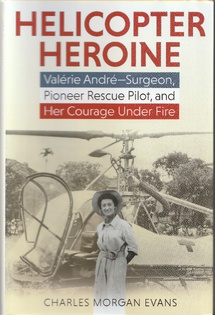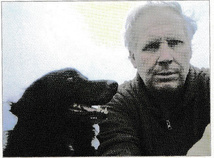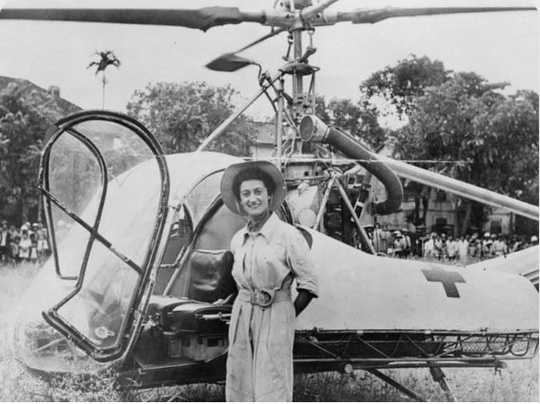Valérie André has played many roles in her storied career.
A risk-taker who didn't belong. A gifted healer.
An angel. A legend. Above all, a daring trailblazer with a firm place in aviation history.
As the first woman to fly a rescue helicopter into combat zones, Captain André completed 129 missions during the French Indochina war. But she was much more than a pioneering medevac pilot.
Dr. André was also a gifted neurosurgeon and an innovator of battlefield medicine. She parachuted into remote outposts to set up medical aid stations and routinely risked her life to treat the wounded-French soldiers, of course, but also villagers and even enemy combatants. Author Charles Morgan Evans skillfully relates Valérie's refusal to submit-to grinding fatigue and illness, enemy gunfire, the skepticism of the French military-and her ultimate triumph.
Valérie André was born in Strasbourg, France, in 1922. From an early age, she wanted to fly, but as a woman, she faced challenges. While boys could receive government-funded flight lessons, André had to pay for hers by tutoring. During World War Il, she left Strasbourg against German prohibitions in order to study medicine in Paris, where she completed her studies under threat of arrest by the Gestapo.
After graduation from medical school in 1947, Valérie volunteered for the French Army and service in French Indochina. She was assigned to an army hospital in Saigon in Vietnam, where she trained as a neurosurgeon. When the French medical corps developed mobile surgical units to be air-dropped into military outposts, Captain André quickly stepped forward. The service acquired a few primitive helicopters, and she volunteered to fly helicopters into combat areas. Besieged by bullets and bombs, fatigue, parasitic illness, and mechanical issues with the helicopters-not to mention the French army's.
prejudice against a female pilot and surgeon-André nonetheless became a legend in Indochina.
After Indochina, she continued to be an innovator in military aviation and medicine as well as an advocate for women's integration into the French military. In 1975, she became the first female general in the French army, and at her retirement, she had flown nearly 500 combat missions, logged 4,000 hours in helicopters, and won the Croix de Guerre five times, the Cross of Military Valor twice, and the Grand Cross of the National Order of Merit.
General Valérie André, who turned 100 in spring 2022, lives near Paris. This book is based on a series of author interviews with her and comprehensive research from other sources.
A risk-taker who didn't belong. A gifted healer.
An angel. A legend. Above all, a daring trailblazer with a firm place in aviation history.
As the first woman to fly a rescue helicopter into combat zones, Captain André completed 129 missions during the French Indochina war. But she was much more than a pioneering medevac pilot.
Dr. André was also a gifted neurosurgeon and an innovator of battlefield medicine. She parachuted into remote outposts to set up medical aid stations and routinely risked her life to treat the wounded-French soldiers, of course, but also villagers and even enemy combatants. Author Charles Morgan Evans skillfully relates Valérie's refusal to submit-to grinding fatigue and illness, enemy gunfire, the skepticism of the French military-and her ultimate triumph.
Valérie André was born in Strasbourg, France, in 1922. From an early age, she wanted to fly, but as a woman, she faced challenges. While boys could receive government-funded flight lessons, André had to pay for hers by tutoring. During World War Il, she left Strasbourg against German prohibitions in order to study medicine in Paris, where she completed her studies under threat of arrest by the Gestapo.
After graduation from medical school in 1947, Valérie volunteered for the French Army and service in French Indochina. She was assigned to an army hospital in Saigon in Vietnam, where she trained as a neurosurgeon. When the French medical corps developed mobile surgical units to be air-dropped into military outposts, Captain André quickly stepped forward. The service acquired a few primitive helicopters, and she volunteered to fly helicopters into combat areas. Besieged by bullets and bombs, fatigue, parasitic illness, and mechanical issues with the helicopters-not to mention the French army's.
prejudice against a female pilot and surgeon-André nonetheless became a legend in Indochina.
After Indochina, she continued to be an innovator in military aviation and medicine as well as an advocate for women's integration into the French military. In 1975, she became the first female general in the French army, and at her retirement, she had flown nearly 500 combat missions, logged 4,000 hours in helicopters, and won the Croix de Guerre five times, the Cross of Military Valor twice, and the Grand Cross of the National Order of Merit.
General Valérie André, who turned 100 in spring 2022, lives near Paris. This book is based on a series of author interviews with her and comprehensive research from other sources.
A propos de l'auteur :
Charles Morgan Evans is the founding curator of the Hiller Aviation Museum in San Carlos, California. He has written about aviation history for such publications as American History, Aviation, and Civil War Times Illustrated, and is author of War of the Aeronauts: A History of Ballooning in the Civil War (Stackpole Books, 2002). He lives in Reno, Nevada, and Coos Bay, Oregon.
Charles Morgan Evans is the founding curator of the Hiller Aviation Museum in San Carlos, California. He has written about aviation history for such publications as American History, Aviation, and Civil War Times Illustrated, and is author of War of the Aeronauts: A History of Ballooning in the Civil War (Stackpole Books, 2002). He lives in Reno, Nevada, and Coos Bay, Oregon.








